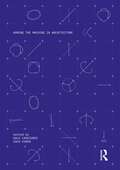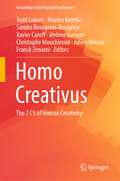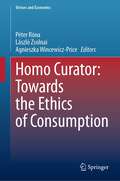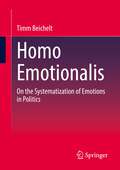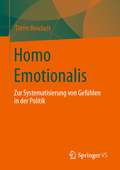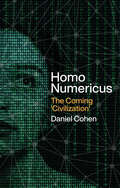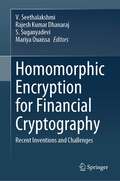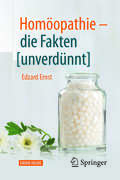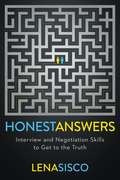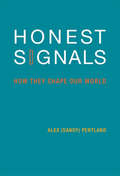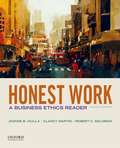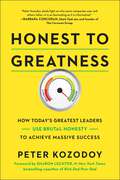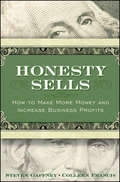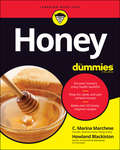- Table View
- List View
Homing the Machine in Architecture
by Galo Canizares Zach CohenHoming the Machine in Architecture is a series of conversations on the ways designers, practitioners, historians, and theorists orient themselves within the world of architectural digital fabrication.To “home” a digital fabrication machine is to send it back to its origin point—a point that can be specified by the fabricator in advance of the fabrication process or by the defaults that are pre-programmed into the machine. The homing process is necessary and productive since it determines the physical point at which the machine (and the maker) begin making—every time that architectural designers begin to digitally fabricate something new, they first need to home the machine. This book gathers first- and second-hand accounts of the origins of individual “digi-fab” practices from the emergence of advanced prototyping tools to the contemporary moment. It features interviews, essays, and case studies organized around three questions: What are the possible histories of digital fabrication in architecture? How do designers orient themselves in this emergent discipline? What conceptual original points do architectural designers return to when they home their machines?The discourse that emerges from this collection aims to reach practicing architects using digital fabrication, as well as upper-level students and academics of digital architecture, architectural theory, and architectural history.
Homo Creativus: The 7 C’s of Human Creativity (Creativity in the Twenty First Century)
by Todd Lubart Marion Botella Samira Bourgeois-Bougrine Xavier Caroff Jérôme Guegan Christophe Mouchiroud Julien Nelson Franck ZenasniThis book focuses on creativity and showcases a specific approach to creativity. It uses a new 7 C’s basis for understanding creativity (creators, creating, cooperation, context, creations, consumption, and curricula). This new approach to creativity is an extension of the 4 ‘P’ approach (person, process, press, and product) which has dominated the literature since the 1960s. In each section, there are two chapters, which illustrate work on the topic and focus on some key issues.
Homo Curator: Towards the Ethics of Consumption (Virtues and Economics #8)
by László Zsolnai Agnieszka Wincewicz-Price Péter RónaThis book explores the under-researched sources of the consumerist culture and the environmental damage it has brought about. The book is an outcome of the symposium on “The Ethics of Consumption” organised and hosted by the Las Casas Institute at the Blackfriars Hall, University of Oxford as part of its Economics as a Moral Science Programme. It takes on two contemporary problems: the human weakness and capacity for wrong-doing, and the failure of modern economic theory to account for the moral character of human behaviour and its implicit encouragement of gluttonous life-styles. In a time when grand political schemes are proposed to revive sustainability of global economy, the authors of the papers collected in this book highlight the need for moral renewal without which the most revolutionary structural reforms are bound to fail at producing the desired outcome. Topics of the book include the meaning and sources of avarice, the attempt to define what is enough, exploration of philosophical and theological perspectives which can serve as building blocks for the ethics of consumption. This makes the book of great interest to a broad readership of economists, social scientists and philosophers.
Homo Emotionalis: On the Systematization of Emotions in Politics
by Timm BeicheltIn this book, important works and approaches of policy-oriented emotion research are brought into a systematic context. For this purpose, three different types of emotions are elaborated, which in their totality constitute Homo Emotionalis: binary emotions, basic emotions, reflexive emotions. They correspond to individual-psychological stages of development, but are also relevant in the social and political handling of emotions. The interplay of emotion types and social constellations leads to different modes of political action, which shape different forms of emotional politics. In each case, individual logics emerge along which emotional politics is pursued. With its interdisciplinary focus, this volume is aimed at political scientists, anthropologists, sociologists and social psychologists.
Homo Emotionalis: Zur Systematisierung von Gefühlen in der Politik
by Timm BeicheltIn diesem Buch werden wichtige Werke und Ansätze der politikorientierten Emotionenforschung in einen systematischen Zusammenhang gebracht. Dafür werden drei unterschiedliche Typen von Emotionen herausgearbeitet, die in ihrer Gesamtheit den Homo Emotionalis ausmachen: binäre Emotionen, Basisemotionen, reflexive Emotionen. Sie entsprechen individualpsychologischen Entwicklungsstufen, sind aber auch im sozialen und politischen Umgang mit Emotionen relevant. Das Zusammenspiel von Emotionentypen und gesellschaftlichen Konstellationen führt zu verschiedenen Modi politischen Handelns, die unterschiedliche Formen von emotionaler Politik prägen. Es entstehen jeweils eigene Logiken, entlang derer Emotionenpolitik betrieben wird. Der Band richtet sich mit seinem interdisziplinären Fokus an Politikwissenschaft*innen, Anthropolog*innen, Soziolog*innen und Sozialpsycholog*innen.
Homo Numericus: The coming 'civilization'
by Daniel CohenFrom Amazon to Tinder, from Google to Deliveroo, there is no facet of human life which the digital revolution has not streamlined and dematerialised. Its objective was to reduce the cost of physical interactions by forgoing face-to-face interactions, a direct result of the free-market shock of the 1980s, which sought to seamlessly expand the marketplace in every possible dimension. Today, we can be algorithmically entertained, educated, cared for and courted in a way which was impossible in the old industrial society, where institutions structured the social world. Today, these institutions have been replaced by monetised virtual contact. As with the industrial revolution of the past, the digital revolution is creating a new economy and a new sensibility, bringing about a radical revaluation of society and its representations. While obsessed with the search for an efficient management of human relations, the new digital capitalism gives rise to an irrational and impulsive Homo numericus prone to an array of addictive behaviours. Far from producing a new agora, social media produce a radicalization of public debate in which hate-filled speech directed against adversaries becomes the norm. The good news is that these outcomes are not inevitable. Technologies have not taken control of our lives. The digital revolution also offers an alternative path: one that leads to a world in which every word deserves to be listened to, without a transcendent truth hanging over it. Are we able to seize the new opportunities opened up by the digital revolution without succumbing to its dark side?
Homo Problematis Solvendis–Problem-solving Man: A History of Human Creativity
by David H. CropleyThis book presents the history of modern human creativity/innovation through examples of solutions to basic human needs that have been developed over time. The title – Homo problematis solvendis – is a play on the scientific classifications of humans (e.g. Homo habilus, Homo erectus, Homo sapiens), and is intended to suggest that a defining characteristic of modern humans is our fundamental ability to solve problems (i.e. problem- solving human = Homo problematis solvendis). The book not only offers new perspectives on the history of technology, but also helps readers connect the popular interest in creativity and innovation (in schools, in businesses) with their psychological underpinnings. It discusses why creativity and innovation are vital to societies, and how these key abilities have made it possible for societies to develop into what they are today.
Homomorphic Encryption for Financial Cryptography: Recent Inventions and Challenges
by Mariya Ouaissa Rajesh Kumar Dhanaraj V. Seethalakshmi S. SuganyadeviThis book offers insights on efficient utilization of homomorphic encryption (HE) for financial cryptography in confidentiality, phishing, anonymity, object and user identity protection. Homomorphic encryption has the potential to be a game-changer for the industry and cloud industry. HE method in cloud computing is presented in this book as a solution to increase the security of the data. Moreover, this book provides details about the set of fundamentals of cryptography, classical HE systems, properties of HE schemes, challenges and opportunities in HE methods, key infrastructure, problem of key management, key sharing, current algorithmic strategies and its limitation in implementation for solving complex problems in financial cryptography, application in blockchain, multivariate cryptosystems based on quadratic equations to avoid the explosion of the coefficients.
Homöopathie - die Fakten [unverdünnt]
by Edzard Ernst Jutta BretthauerHomöopathie und Wissenschaft Dieses Buch zeichnet die Entstehung der Homöopathie nach, erläutert ihre grundlegenden Prinzipien, klärt über die heutige Praxis auf und diskutiert die Gründe für die anhaltende Beliebtheit dieser Heilmethode. Vor zweihundert Jahren hatte die Medizin Kranken wenig zu bieten: Man ließ sie zur Ader oder verabreichte ihnen extrem starke Abführmittel – Praktiken, die den Krankheitsverlauf verkürzten, indem sie den Tod des Patienten beschleunigten. Vor allem als Reaktion auf diese brachiale und ineffektive Medizin entwickelte der deutsche Arzt Samuel Hahnemann im ausgehenden 18. Jahrhundert ein therapeutisches System, das er als Homöopathie bezeichnete. Während sich die Medizin seit jener Zeit enorm gewandelt und weiterentwickelt hat, wird die Homöopathie – mit ihren Wurzeln in Alchemie und Metaphysik – heute noch genauso praktiziert wie in Hahnemanns Tagen. Die Leser dieses Buches werden nicht nur die Geschichte der Homöopathie und ihrer fast magischen Anziehungskraft kennen lernen, sondern vor allem die rationale und wissenschaftliche Herangehensweise des Autors zu schätzen wissen, der in kompakter Form die gesamte Bandbreite der biologischen, chemischen und psychologischen Fragen beleuchtet, die diese Behandlungsform aufwirft.
Hon Hai's Investment in Sharp
by Mihir A. Desai Keith Chi-ho Wong Zachary MarkovichIn March 2012, Hon Hai Precision Industry Company, Ltd. (Hon Hai) announced its investment in the Sharp Corporation (Sharp). The deal was structured in two parts: the first had Hon Hai investing in Sharp, and the second involved Hon Hai founder and chairman and CEO Terry Guo personally purchasing a stake in Sharp's unprofitable Sakai manufacturing plant. This case explores the dynamics of the deal and specifically focuses on valuation of the investment in the Sakai plant as well as the structure of the deal. It presents a vehicle by which to consider net present value (NPV) calculations and corporate deal structuring.
Honda (A)
by Richard Tanner Pascale Evelyn T. ChristiansenDescribes the history of Honda Motor Company from its beginning through its entry into and subsequent dominance of the U.S. market. The history is explained primarily in terms of strategic factors and quoted from two sources: an earlier case and Boston Consulting Group report on the motorcycle industry. Should be used with Honda (B).
Honda (B)
by Richard Tanner Pascale Evelyn T. ChristiansenDescribes the history of Honda Motor Company from its beginning through its entry into and subsequent dominance of the U.S. market as seen through the eyes of Honda executives. The history of Honda's successful entry into the U.S. market is viewed as highly adaptive and fraught with error and serendipity. Honda (A) and (B) are designed to be used together to contrast two differing views of major events in a company's history, both of which are important for a general manager to understand.
Honda Innovations: Leveraging External Insights to Accelerate Creation
by Antonio DavilaNick Sugimoto, CEO of Honda Innovations-the open innovation organization of Honda, has to decide how to extend his organization's approach to innovation across the world. Honda Innovations dates back to 2000 when Honda created Honda Research Institute in Silicon Valley. Since then, the organization has evolved through various models from a venture capital fund to its current form as Honda's corporate innovation effort. The case describes the various approaches to innovation between Honda and outside firms and how it fits into an increasingly dynamic car industry.
Honda Today
by Marco Iansiti Barbara FeinbergDescribes a situation in which the manager in charge of a major development project at Honda needs to make a decision about the technical specification of the product. The decision has profound implications for the product concept and strategy, as well as for the technical feasibility and challenges of the design. The students need to evaluate different options and estimate their impact on the success of the final product. Underlines the importance of choosing an option that is consistent with the overall concept of the product and the company's design and philosophy.
Honda-Rover (A): Crafting an Alliance
by James K. Sebenius Ashish Nanda Ron S. FortgangFaced with vexing financial challenges in 1993, British Aerospace (BAe) is determined to shed its loss-making automaker, Rover. It offers to sell its stake in Rover to Honda, Rover's partner since 1979, but Honda is reluctant to raise its stake in Rover. Meanwhile, BMW approaches BAe with a confidential bid to buy out Rover. This case places these developments within the context of the history of the British auto industry, Rover's heritage, evolution of the Honda-Rover partnership, and the rationale for BMW's interest in Rover. The case series describes subsequent developments.
Honda-Rover (C): "The Sting"
by James K. Sebenius Ashish Nanda Ron S. FortgangSupplements the (A) case.
Honest Answers: Interview and Negotiation Skills to Get to the Truth
by Lena SiscoBECOME A MASTER AT NEGOTIATION AND COMMUNICATIONNever go into an important conversation feeling unheard, unprepared, or uninformed again—apply the proven SISCO method for communication to become a master negotiator, trusted interviewer, and engaging conversationalist. No matter the conversation, detecting honesty and persuading others to be honest are some of the most valuable skills you can learn. With these skills, you can master your daily conversations and interactions with others. The Strategic Interviewing Skills and Competencies (SISCO) Method will help you see the full picture, have all the facts, and make effective decisions.Former Navy interrogator, Lena Sisco, created this method during challenging investigative and information-gathering interviews. Her 5-step program focuses human-to-human interaction. When you can gain someone&’s trust you can get truth in any scenario. She teaches readers how to validate their gut feeling when they think someone is lying, unassumingly control a conversation, and persuade others to be honest.These skills are not only applicable in an interrogation room, but they can be relevant in everyday life. In this book, you will learn how to:Apply the strategic interviewing skills behind the SISCO method to your everyday life to discover the information and the honest answers you need.Create an environment of trust that will facilitate the fact finding necessary to be more effective at your job while encouraging others to be more accountable.Control the signals you may or may not be inadvertently sending to others.Know the right words to say during a disagreement in order to de-escalate conflict, gain respect, and create a win-win situationNot only does she teach you techniques and methods to negotiate and interview with confidence, she shares the neuroscience behind why they are effective. You will be able to interpret patterns of behavior and influence positive behaviors in others, as well as enhancing the effectiveness of your communication practices; both verbal and nonverbal.
Honest Signals
by Alex Sandy PentlandHow can you know when someone is bluffing? Paying attention? Genuinely interested? The answer, writes Sandy Pentland in Honest Signals,is that subtle patterns in how we interact with other people reveal our attitudes toward them. These unconscious social signals are not just a back channel or a complement to our conscious language; they form a separate communication network. Biologically based "honest signaling," evolved from ancient primate signaling mechanisms, offers an unmatched window into our intentions, goals, and values. If we understand this ancient channel of communication, Pentland claims, we can accurately predict the outcomes of situations ranging from job interviews to first dates. Pentland, an MIT professor, has used a specially designed digital sensor worn like an ID badge--a "sociometer"--to monitor and analyze the back-and-forth patterns of signaling among groups of people. He and his researchers found that this second channel of communication, revolving not around words but around social relations, profoundly influences major decisions in our lives--even though we are largely unaware of it. Pentland presents the scientific background necessary for understanding this form of communication, applies it to examples of group behavior in real organizations, and shows how by "reading" our social networks we can become more successful at pitching an idea, getting a job, or closing a deal. Using this "network intelligence" theory of social signaling, Pentland describes how we can harness the intelligence of our social network to become better managers, workers, and communicators.
Honest Signals: How They Shape Our World (The\mit Press Ser.)
by Alex PentlandHow understanding the signaling within social networks can change the way we make decisions, work with others, and manage organizations.How can you know when someone is bluffing? Paying attention? Genuinely interested? The answer, writes Alex Pentland in Honest Signals, is that subtle patterns in how we interact with other people reveal our attitudes toward them. These unconscious social signals are not just a back channel or a complement to our conscious language; they form a separate communication network. Biologically based “honest signaling,” evolved from ancient primate signaling mechanisms, offers an unmatched window into our intentions, goals, and values. If we understand this ancient channel of communication, Pentland claims, we can accurately predict the outcomes of situations ranging from job interviews to first dates.Pentland, an MIT professor, has used a specially designed digital sensor worn like an ID badge—a “sociometer”—to monitor and analyze the back-and-forth patterns of signaling among groups of people. He and his researchers found that this second channel of communication, revolving not around words but around social relations, profoundly influences major decisions in our lives—even though we are largely unaware of it. Pentland presents the scientific background necessary for understanding this form of communication, applies it to examples of group behavior in real organizations, and shows how by “reading” our social networks we can become more successful at pitching an idea, getting a job, or closing a deal. Using this “network intelligence” theory of social signaling, Pentland describes how we can harness the intelligence of our social network to become better managers, workers, and communicators.
Honest Tea
by Paul A. GompersThis case examines the decisions of Seth Goldman and Barry Nalebuff, founders of Honest Tea. Honest Tea is a start-up in the ready-to-drink tea market. Goldman and Nalebuff must craft an expansion and financing strategy.
Honest Work: A Business Ethics Reader
by Clancy Martin Joanne B. Ciulla Robert C. SolomonIn today's business world, ethics is not simply a peripheral concern of executive boards or a set of supposed constraints on free enterprise. Ethics stands at the very core of our working lives and of society as a whole, defining the public image of the business community and the ways in which individual companies and people behave. What people do at work--and how they think about work--determines their attitudes and aspirations, affecting and even structuring their personal lives and habits. <P><P>Working from this premise, Honest Work: A Business Ethics Reader provides a practical overview of business ethics that concentrates on the ethical problems and dilemmas students are most likely to face in their prospective work environments. Classic and recent articles and cases cover a broad spectrum of issues and concerns--from private ethical dilemmas to larger considerations of corporate values--and propose guidelines for thinking about the business world in a moral context. Each reading and case is followed by lively questions for discussion. <P><P>Offering a welcome alternative to the impersonal tone of most business ethics texts, the editors address students in an appealing and conversational manner. They provide engaging chapter introductions that include personal narratives and also present the ideas of great philosophers in a unique way--as emails. <P><P>Ideal for introductory undergraduate and MBA courses in business ethics, Honest Work: A Business Ethics Reader can be read as a coherent narrative but also offers instructors great flexibility, as its various chapters, readings, and cases can be pursued in almost any order. A Companion Website featuring chapter objectives and summaries, study questions, self-tests, and off-site links of interest will soon be available. An Instructor's Manual with Test Bank is available to adopters.
Honest to Greatness: How Today's Greatest Leaders Use Brutal Honesty to Achieve Massive Success
by Peter KozodoyIn today's hyper-transparent world, consumers have enormous power to decide which brands are worth their time and money—so how do you make sure they choose yours? Unfortunately, most leaders and organizations are stuck following archaic, detrimental business practices. Meanwhile, savvy consumers and employees across every generation are making their stance perfectly clear: They are not interested in supporting organizations that seem inauthentic, soulless, or untrustworthy. In this environment, only the honest will survive. In Honest to Greatness, serial Inc. 5000 entrepreneur Peter Kozodoy shows how today's greatest business leaders use honesty—not as a touchy-feely core value, but as a business strategy that produces game-changing, industry-dominating success. Through case studies and interviews with leaders at Bridgewater Associates, Sprint, Quicken Loans, Domino's, The Ritz-Carlton, and more, Kozodoy presents fresh business concepts that anyone in the workplace can implement in order to: Reach, engage, and retain your best customers Attract and inspire the best talent in any industry Create an unbeatable culture of innovation that dominates your competitors Earn your team's respect and loyalty Unlock deep personal fulfillment by setting the "right" goals Filled with powerful lessons for current and future leaders, this timely book demonstrates how to use honesty at both the organizational and individual level to achieve true greatness in business and in life.
Honesty Sells
by Steven Gaffney Colleen FrancisLooking for an edge in today's tough selling market? Honesty Sells challenges you to abandon clichéd sales techniques that rely on manipulation and deceit. Instead, by being honest and open with clients, you will be rewarded with long-term, profitable relationships-at the expense of no one but your competition. . . PRAISE FOR HONESTY SELLS "I've been in the field of sales leadership for twenty-four years with a major organization. I've recruited, trained, and developed thousands of salespeople over those years. Where has this book been? It should be a must-read for every new salesperson. This is a simple topic that isn't easy to execute day to day. Honesty Sells helps you change your mental map about how to approach business and relationships. Do the right thing. . . . always!" -Scott DiGiammarino, Group Vice President, Ameriprise Financial "Honesty Sells has already made a huge impact in my business and it's a keeper. I recommend it for any business CEO trying to maximize and keep their profits. " -Richard Strauss, President, Strauss Radio Strategies, Inc. "Honesty Sells is not just a book for salespeople. As a public relations professional, Gaffney and Francis's solid principles and coaching have helped me to develop and maintain relationships that are key to the success of my business. " -Avery Mann, Director of Media & Public Relations, FOX TV's America's Most Wanted "Literally thirty minutes after absorbing their sales advice, I was on the phone applying concepts and strategies that enabled me to effectively move forward a deal accounting for 57 percent of my quota for the entire sales quarter. Here's the best part: this was during my first month on the job. " -Raj Shahani, Yahoo! "Thank you so much for the inspiration. Your selling techniques were just the shot in the arm that this old veteran really needed. I have four new clients in just a week's time! Hip hip hooray!!" -Nancy Daniels, Regional Director, HelmsBriscoe "A top-notch sales pro who knows how to make progress in a difficult market. Bad economy. Government sales. Makes no difference-the job gets done. " -Paul Lemberg, Lemberg and Associates "In addition to the practical and proven tips and techniques, this advice is based on extensive sales research and investigation with respect to what produces results. All the 'out of the box' suggestions are attention-getting but also get results!" -Janet Armstrong, Director, Management Consulting, Ajilon Consulting
Honey For Dummies
by Howland Blackiston C. Marina MarcheseGet in on the ground level of the next artisan food obsession—honey! Just like wine, cheese, beer or coffee, honey is an artisan food with much to be discovered. Whether you're interested in tasting the various varietals, using it as a cure, or harvesting your own, Honey For Dummies is the guide for you. This book reveals the deep and complex world of honey, its diverse floral sources, and its surprising range of colors, smells, and flavors. You will learn about over 50 single-origin honeys, their sensory profiles, where they are produced and where to buy them. Discover how to taste and evaluate honey using the same methods as professional honey sensory expert. Understand how honey is produced by honeybees, and how beekeepers harvest, and bottle this liquid gold. You'll also discover the historical role honey has played around the world in folklore, religions, and economies. From its health benefits, to recipes, to food pairings, this complete guide covers all things honey! Honey is the latest food trend that can be found at farmers' markets, specialty food shops and on the menu of restaurants. It is produced from bees in every state and just about every country on the planet. Let Honey For Dummies accompany you on your sweet adventure! Discover the rich and complex world of single-origin honey Learn about honey's composition and its myriad health benefits Acquire the skills to taste honey like a pro then how to perfectly pair honeys with all foods Try the book's many wonderful recipes that incorporate honey Honey For Dummies is the perfect companion for every chef, brewer, homesteader, beekeeper or honey lover.
Honey and Vinegar: Incentives, Sanctions, and Foreign Policy
by Richard N. Haass Meghan L. O'SullivanButtressed by input from scholars, diplomats, and observers with an intimate knowledge of U. S. foreign policy, Honey and Vinegar examines "engagement" -- strategies that primarily involve the use of positive incentives. The book contends that although engagement has received little scrutiny relative to other, more punitive foreign policy approaches, it has great potential as a tool for modifying the behavior of regimes with which the United States has significant disagreements. Heightened awareness of the costs associated with the use of sanctions or military force has catalyzed a search for policy alternatives. In this quest to find other appropriate policy options for pursuing foreign policy goals, strategies of engagement warrant serious consideration. As argued in these pages, the use of incentives, rather than penalties, may be particularly well suited to the post Cold War world, where globalization has made the economic isolation of any country difficult to achieve. At the same time, the collapse of the,Soviet Union has meant that American carrots may be especially savory to many regimes once reliant on Soviet support. Paradoxically, engagement can be a good choice, even when it fails, in that it can open the door for other policy options. For instance, the two years in which America tried to engage Saddam Hussein before the Gulf War worked to the advantage of the United States later. After Iraq's invasion of Kuwait in 1990, American efforts to build a military coalition to oppose Iraq were facilitated by the sense in the region that the United States had earlier pursued a conciliatory policy, but to no avail. Contributors to this volume have provided seven cases exploring episodes of engagement: relations between the United States and China; Europe's "Critical Dialogue" with Iran; U. S. engagement with Iraq from 1988 to 1990; U. S. efforts to engage North Korea; the combination of U. S. persuasion and coe
